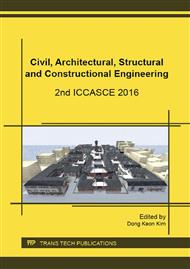[1]
M. S. Paterson, T. F. Wong, Experimental rock deformation: the brittle field, 2nd ed. New York: Springer Verlag, (2005).
Google Scholar
[2]
J. Singh, Strength of rocks at depth, In: Maury V, Fourmaintrax D, eds. Rock at Great Depth. Rotterdam: A A Balkema, 1989, 37-44.
Google Scholar
[3]
S. NEMAT-NASSER, H. HORII, Rock failure in compression, Int. J. Eng. Sci. 22(8-10) (1984) 999-1011.
DOI: 10.1016/0020-7225(84)90101-0
Google Scholar
[4]
F. Dai, K. Xia, L. Z. Tang, Rate dependence of the flexural tensile strength of Laurentian granite, Int. J. Rock. Mech. Min. Sci. Article in press, 47(3) (2009) 469-475.
DOI: 10.1016/j.ijrmms.2009.05.001
Google Scholar
[5]
Y. Yu, J. X. Zhang, J. C. Zhang, A modified brazilian disk tension test, Int. J. Rock Mech. Min. Sci. 46 (2009) 421-425.
Google Scholar
[6]
X. B. Li, Z. L. Zhou, T. S. Lok, et al. Innovative testing technique of rock subjected to coupled static and dynamic loads, Int. J. Rock Mech. Min. Sci. 45(5) (2008) 739-748.
DOI: 10.1016/j.ijrmms.2007.08.013
Google Scholar
[7]
X. B. Li, Z. L. Zhou, Z. Y. Ye, et al. Study of rock mechanical characteristics under coupled static and dynamic loads, Chin. J. Rock Mech. Eng. 27(7) (2008) 1387-1395. (In Chinese).
Google Scholar
[8]
Golshani, Aliakbar, Y. Okui, et al. A micromechanical model for brittle failure of rock and its relation to crack growth observed in triaxial compression tests of granite, Mech. Mater. 38(4) (2006) 287-303.
DOI: 10.1016/j.mechmat.2005.07.003
Google Scholar
[9]
H. B. Li, J. Zhao, T. J. Li, Micromechanical modeling of the mechanical properties of a granite under dynamic uniaxial compressive loads, Int. J. Rock Mech. Min. Sci. 37(6) (2000) 923-935.
DOI: 10.1016/s1365-1609(00)00025-3
Google Scholar
[10]
H. Zhao, G. Gary, On the use of SHPB techniques to determine the dynamic behavior of materials in the range of small strains, Int. J. Solids Struct. 33(23) (1996) 3363-3375.
DOI: 10.1016/0020-7683(95)00186-7
Google Scholar
[11]
X. B. Li, D. S. Gu, Rock impact dynamics, Changsha: Press of Central South University of Technology, 1994. (In Chinese).
Google Scholar
[12]
Z. X. Zhang, An empirical relation between mode I fracture toughness and the tensile strength of rock, Int. J. Rock Mech. Min. Sci. 39(3) (2002) 401-406.
DOI: 10.1016/s1365-1609(02)00032-1
Google Scholar


